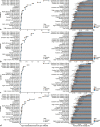Global Burden and Its Association with Socioeconomic Development Status of Meningitis Caused by Specific Pathogens over the Past 30 years: A Population-Based Study
- PMID: 37399794
- PMCID: PMC10641806
- DOI: 10.1159/000531508
Global Burden and Its Association with Socioeconomic Development Status of Meningitis Caused by Specific Pathogens over the Past 30 years: A Population-Based Study
Abstract
Background: Meningitis is a severe and fatal neurological disease and causes lots of disease burden. The purpose of this study was to assess the global, regional, and national burdens and trends of meningitis by age, sex, and etiology.
Methods: Data on the burden of meningitis were collected from the Global Burden of Diseases, Injuries, and Risk Factors Study 2019. R and Joinpoint were used for statistical analysis and charting.
Results: In 2019, meningitis caused 236,222 deaths and 15,649,865 years of life lost (YLL) worldwide. The age-standardized death rate and age-standardized YLL rate of meningitis were 3.29 and 225, which decreased steadily. Burden change was mainly driven by epidemiological changes. Regionally, meningitis burden was the highest in Sub-Saharan Africa. Burden of disease increasingly concentrated in low sociodemographic index countries, and this was most pronounced in meningitis caused by N. meningitidis. Countries such as Mali, Nigeria, Sierra Leone, etc., especially need to enhance the rational allocation of public health resources to reduce the disease burden. Children and men were more likely to be affected by meningitis. PM2.5 was found to be an important risk factor.
Conclusions: This study provides the first comprehensive understanding of the global disease burden of meningitis caused by specific pathogens and highlights policy priorities to protect human health worldwide, with particular attention to vulnerable regions, susceptible populations, environmental factors, and specific pathogens.
Keywords: Global Burden of Disease; Meningitis; Pathogen; Socioeconomic status.
© 2023 The Author(s). Published by S. Karger AG, Basel.
Conflict of interest statement
The authors declare they have no conflicts of interest regarding the content of this paper.
Figures






References
MeSH terms
LinkOut - more resources
Full Text Sources
Medical
Miscellaneous

